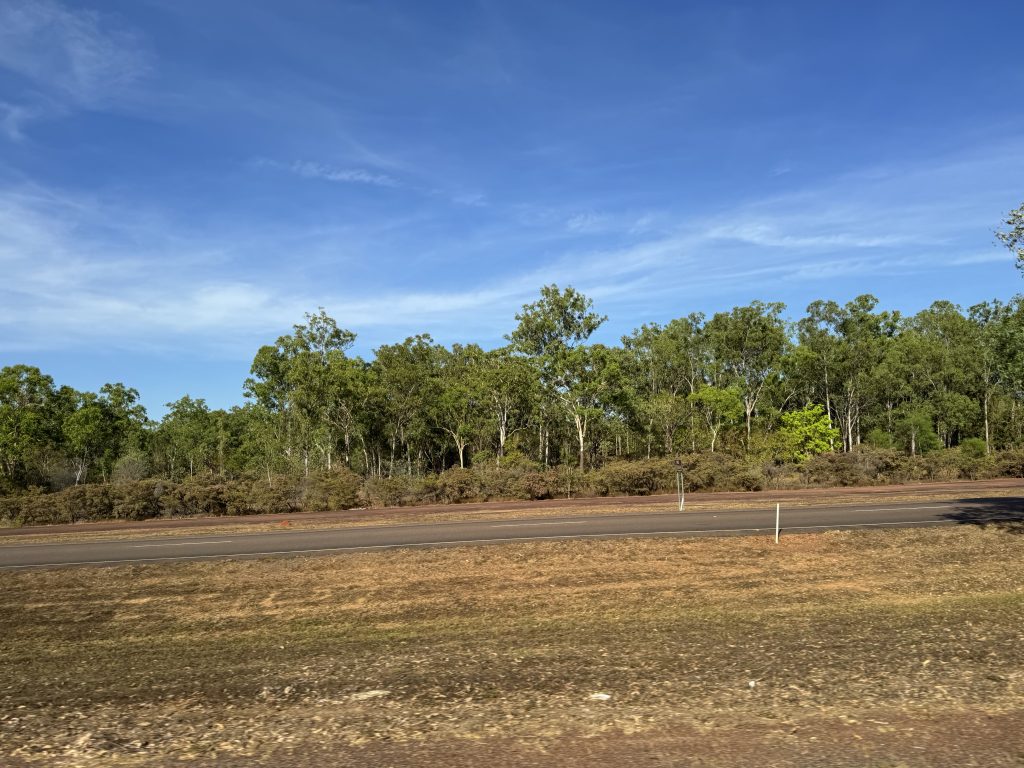
We were picked up bright and early for our tour into Kakadu. This shot is taken from the bus. The red strip beside the road is a WWII airstrip. There was no point in having a proper airport when the Japanese were bombing us all the time.
My grandfather, George Stephens, was a mechanic on the planes in WWII. I feel like I’m retracing his footsteps.
Our guide, Pascal, retailed us with all sorts of information on our way into Kakadu.
Darwin has the longest airstrip in the southern hemisphere. Any emergency NASA space stuff that happens in this part of the world comes here. The airport doubles as the RAF base.
The military presence in Darwin is quite high. Understandable, as it’s the biggest city at the top of the country.
Darwin Harbour is twice the size of Sydney Harbour. China has leased it on a 99 year lease. I have no comment.
Palmerston popped up after Cyclone Tracey as a secondary city while Darwin was being rebuilt. Now it’s the second largest city in the NT, with 75,000 people.
As we drive, I’m looking at the size of the road trains, gauging how fast I’ll have to drive to overtake them in November. Eve, from the Alice Springs rip, told me that when they indicate to tell you it’s safe, you just put your foot down and GO.
To go into an Aboriginal community, you need permission. Our tour doesn’t have that.
We passed through a little town called Coolalinga, which is a mash-up from a caravan park slogan. They installed an above-ground pool and their slogan was: “You can cool off and linger here longer.” The next stop for food, fuel etc is Katherine … which is 5 hour’s drive away. You’d want to be sure you have everything you need before you leave here!
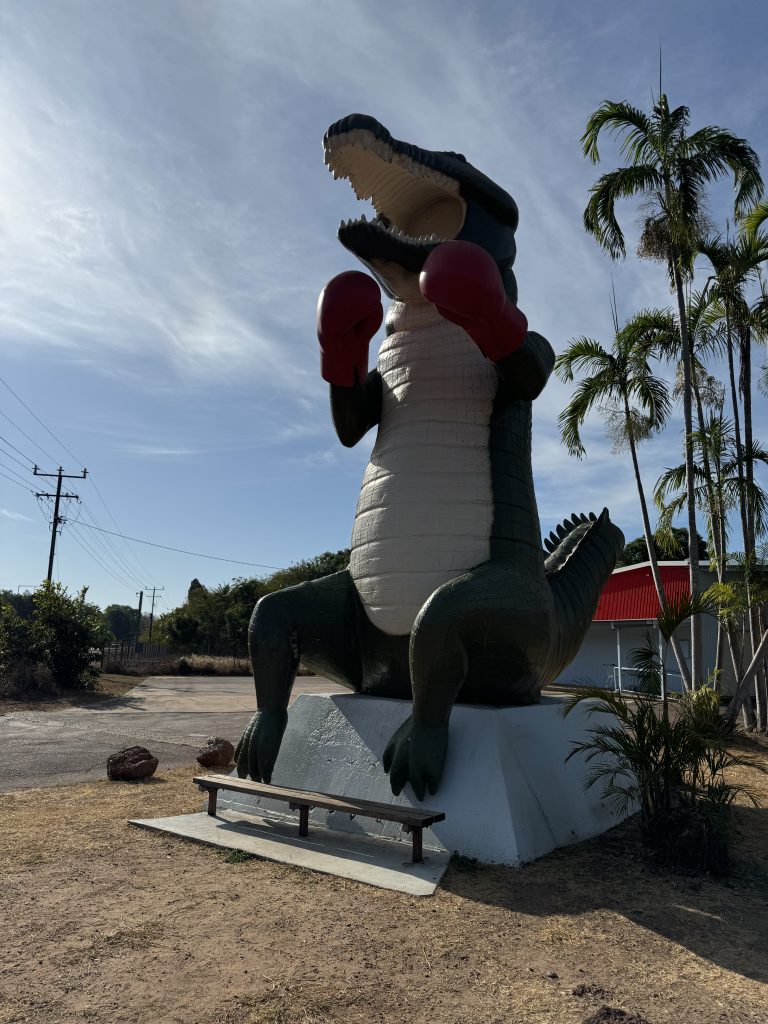
The bus is almost full, with 12 couples and me as the only single. Much as I liked travelling with Megan in Canada/Alaska and Eve, I have to say that I like having both seats to myself on the bus. After all, with the single supplement, I’ve paid for around half that seat anyway!
Less than an hour’s drive from the centre of Darwin, Pascal told us to keep an eye open for crocodiles beside the road in pools of water.
That’s very close!
Our first little stop was the boxing crocodile at Humpty-Doo.
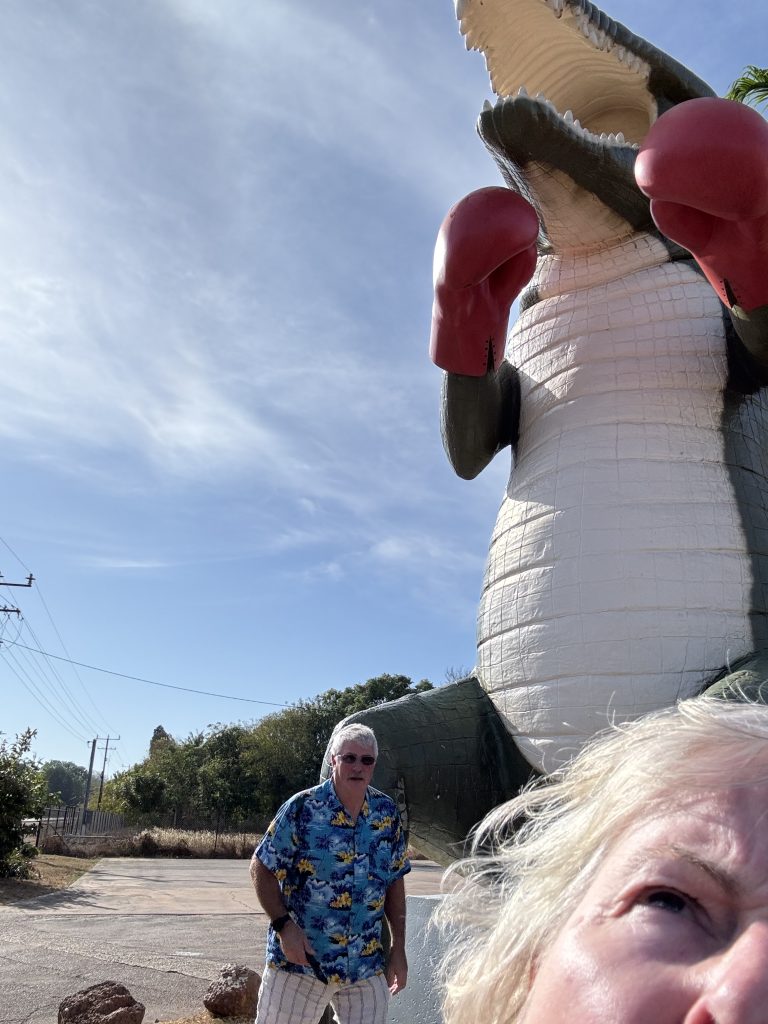
Here’s me being mystified. It’s 30 metres tall and is made of fibreglass to withstand our crazy weather up here. The roadhouse owner, a mad yachting fan, put it up after Australia won the America’s Cup.
Yes, I don’t know why, either.
A Darwin stubbie is 2 litres. People tend to get thirsty up here, I guess.
Humpty Doo is where in 1954 Bob Hawke, our former Prime Minister, sculled a yard glass (two and a half pints) of beer in just eleven seconds – an achievement that earned him a spot in the Guinness Book of Records.
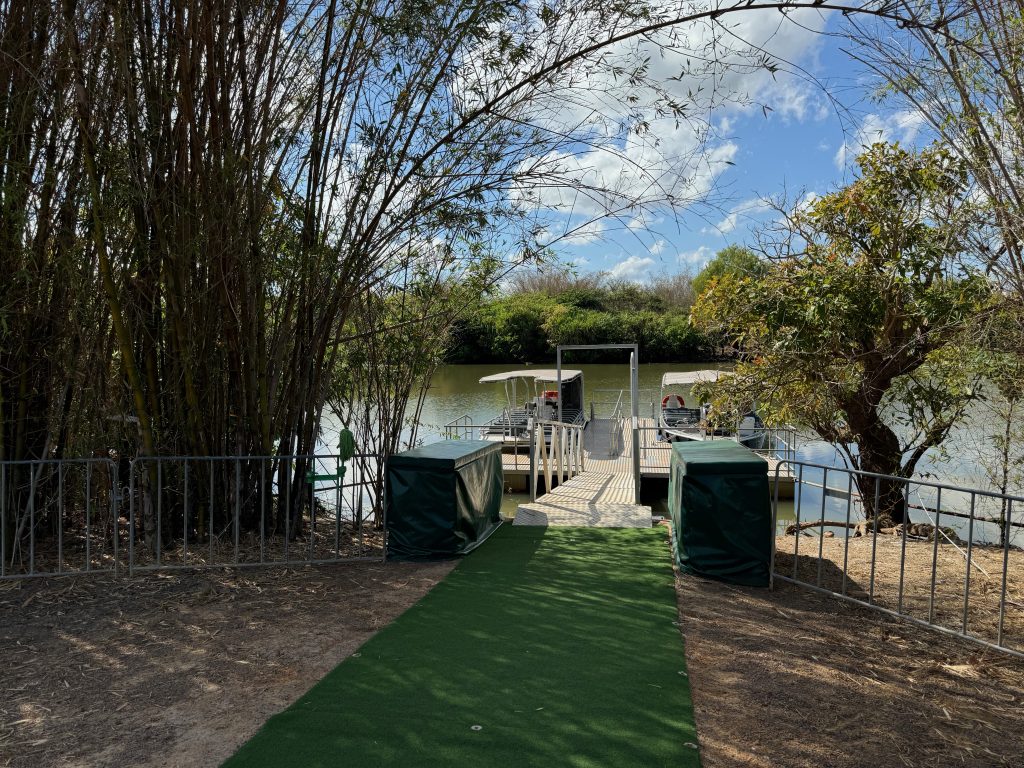
Our first real stop for the day was a boat cruise on the Corroboree Billabong. Normally at this time of the year, you’d expect to see crocodiles everywhere, sunning themselves on the banks before the water grew warm enough for them. Due to an unseasonable blast of warmer weather over the last few days, the water’s temperature is around 29C, which is warm enough for them to feel more comfortable in the water than out, so we were warned that pickings might be slim.
However, there was still plenty to see.
The cattle station we’re driving on is double the size of Singapore. In the wet season, it has 10 people working on it, basically just caretaking. That changes to around 100 people in the Dry. There are around 90,000 head of cattle.
An area DOUBLE the size of Singapore with only 100 people on it. This land is VAST.
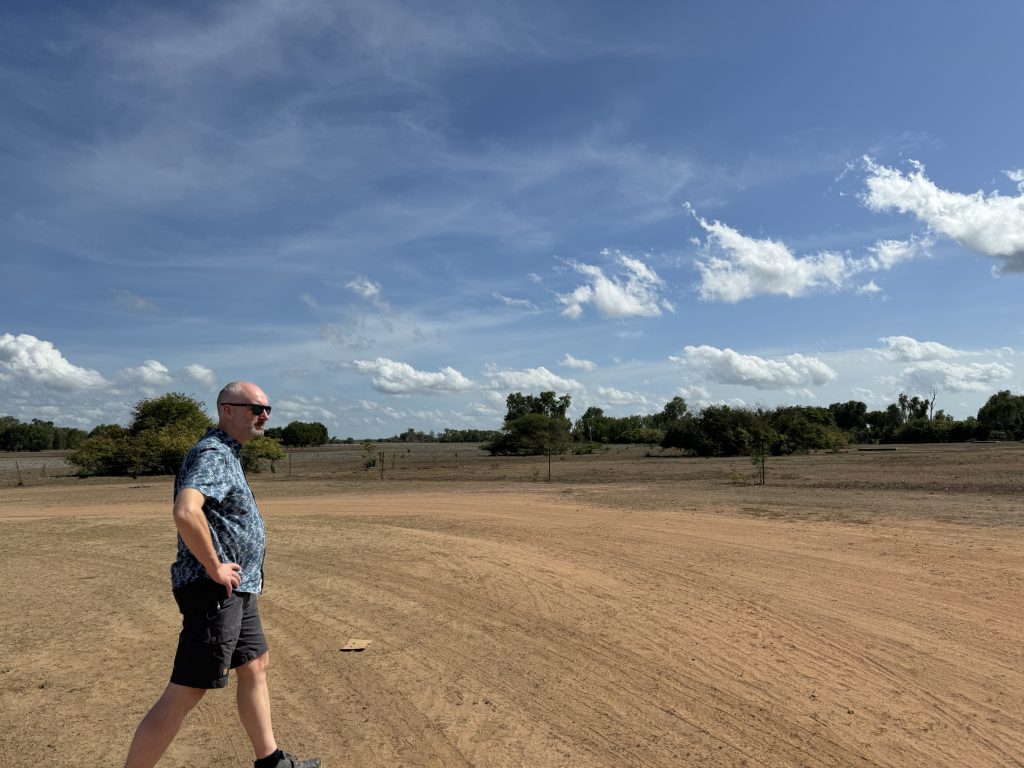
The first thing we heard about was how different this place looks in the Wet.
See all of this ground that we’re walking on? In June, all of this ground was under 3.5 metres of water. THE WHOLE THING. This means the river has dropped 3.5m since winter. It’s definitely feast or famine in this country.
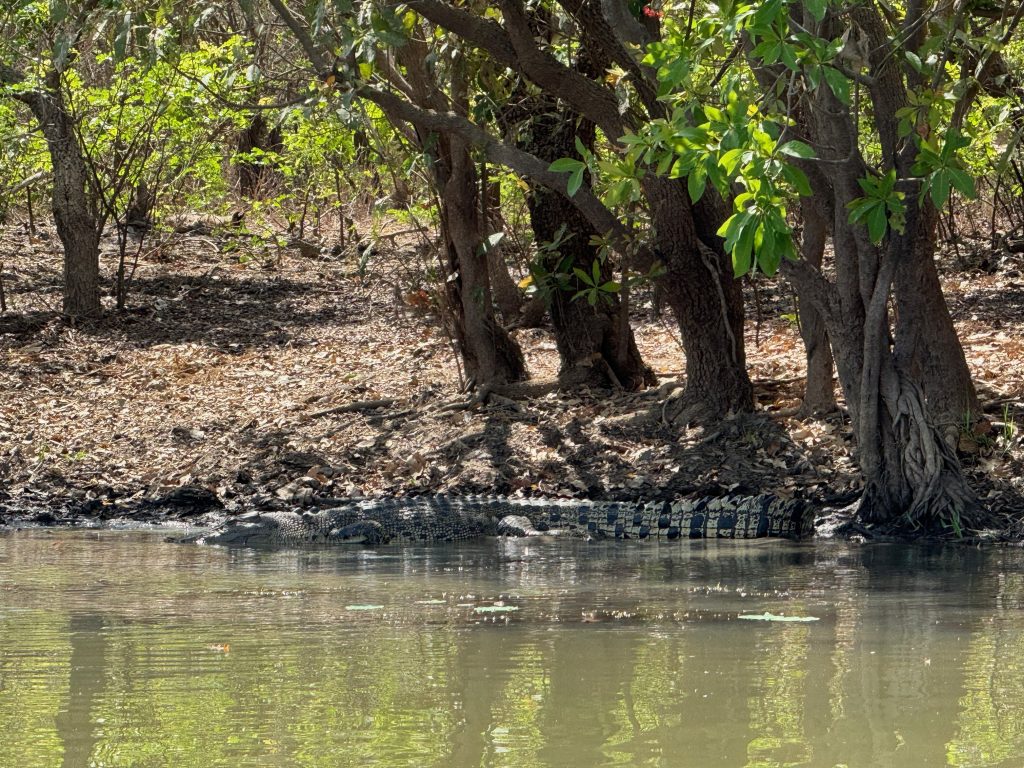
The billabong is a freshwater wetland, and we set out on a flat-bottomed boat for bird and animal spotting. We were warned about putting any body parts outside the boat, and were also told that if we were stupid unfortunate enough to fall in, “We’ll pull you in… or what’s left of you.”
The crocodiles were all around us. Just because we couldn’t see them, doesn’t mean that they weren’t there. This area has the highest concentration of Salties in the world. This one in the photo above is around 4 metres. Salties can grow up to 6 metres.
As we were driving there, Pascal said:
“You’ll see some Salties as you can find them in salt water, but folks, crocodiles actually prefer to be in fresh water because they get to eat the animals that come to drink fresh water. So it will be your buffalo, your cattle, all the real tasty stuff, so we do have to be very vigilant and aware of any body of water. It doesn’t matter if it’s a small or a large body of water – you just assume there’s a crocodile as we drive along the highway. Keep an eye on those drying-up puddles as we drive through. There is a big 4 1/2 meter croc under the next bridge, living in a pond smaller than my cabin.
“They’re an apex predator. They can be under 5 cm of water and you wouldn’t know they’re there. They can hold their breath so they take you. You’re not holding your breath. You’re not a crocodile, so you need to stay around 5 metres or so from the water’s edge. The crocodiles move so fast that it takes 5 metres for your brain to recognise that a crocodile is trying to attack you, so that’s enough time for your brain to move your legs and run.
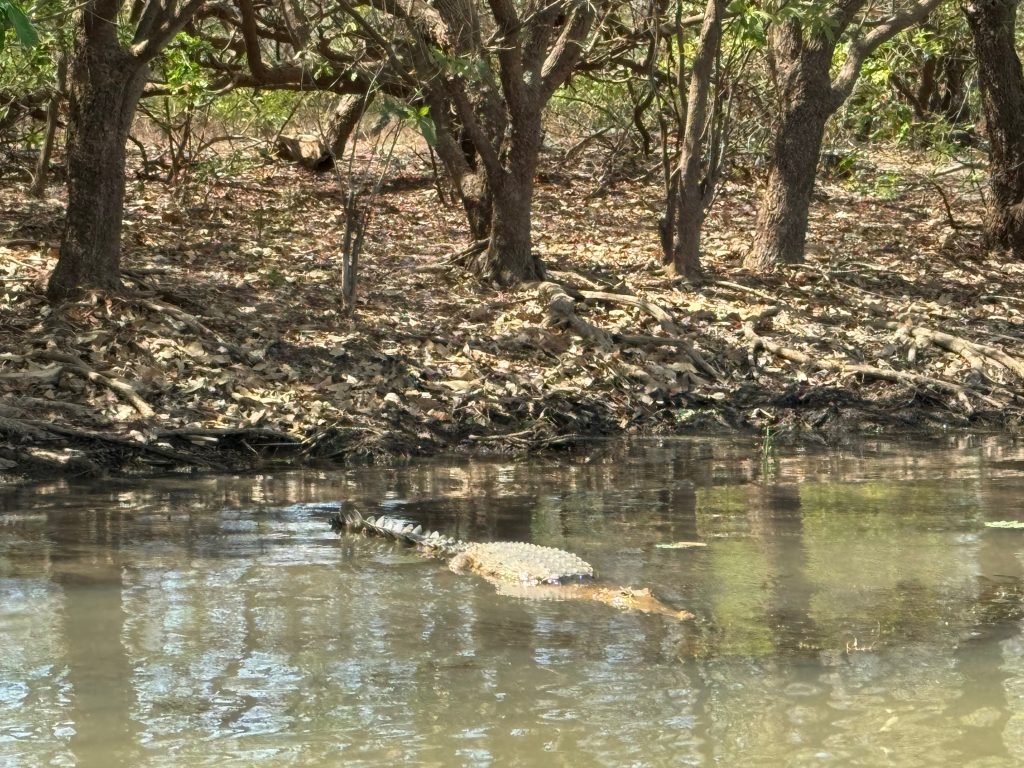
“If you’re like me and you just freeze and wet your pants and you can’t move because you’re so scared, do like I do and stand further away from the water’s edge.
“They say 3 1/2 metres and above is a Maneater. Small crocodiles like to death roll so you can possibly get out of it while they’re trying to death roll you and rip pieces of flesh off. It’s the big ones that you really gotta watch out for. They’ll grab you and sink to the bottom and drown you. They’ll bring you back because they don’t have a hinge on their jaws. Can’t chew like us. They crunch your body with teeth crunch, crunch, crunch from the toes all the way to the head, back down tenderising and then they do something called the Head Snap.
“They snap their neck and rip you in half. I’ve seen it happen. I’ve heard the noise and that does not leave you. It’s something that will always stay in your brain. So terrifying.
“These crocodiles do jump as well folks, they can jump about 3/4s of their body out of the water, so your arms outside of the boat is a big no-no. This river is said to have the highest concentration of Saltwater crocodiles in the world, which is one every 10 m². If you can’t see them, it doesn’t mean they’re not there, so please don’t put ANY body part outside of the boat. Might not come back if you do…”
We only saw 2 crocodiles on this tour. But we saw plenty of birds to make up for it.
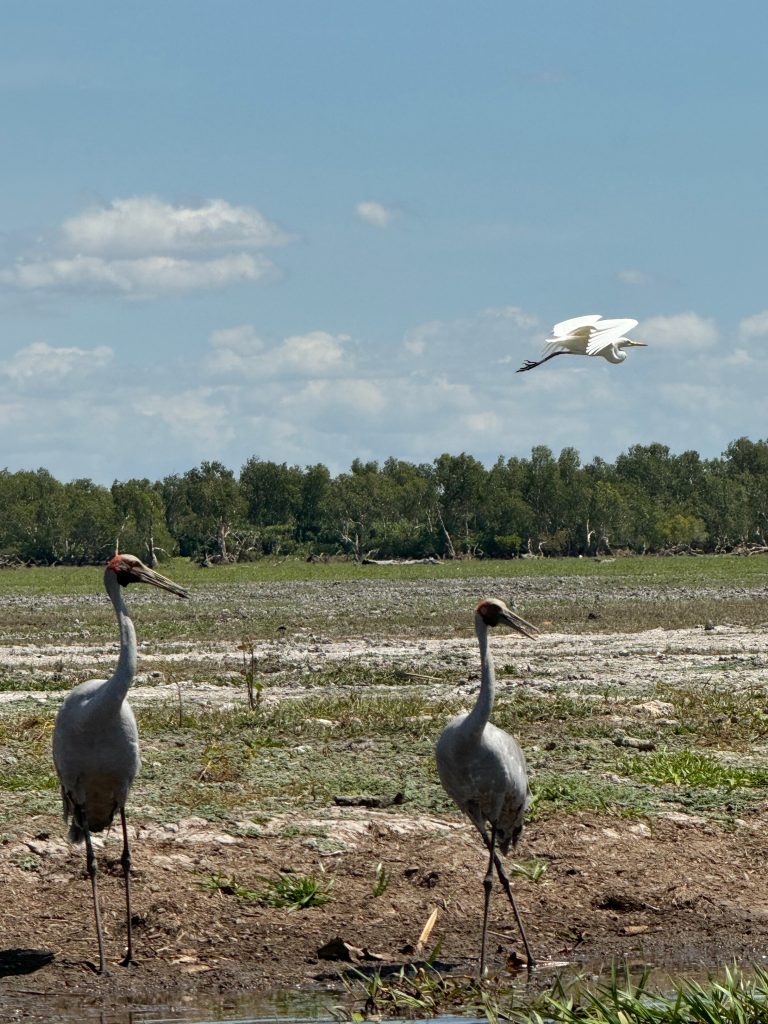
Brolgas! I’ve never seen them before.
They mate for life and are famous for their courtship dance. The male grabs a stick, jumps around with it and if she likes it, they’re together! These two were so still at the water’s edge, just checking us out. I have far too many photos of them.
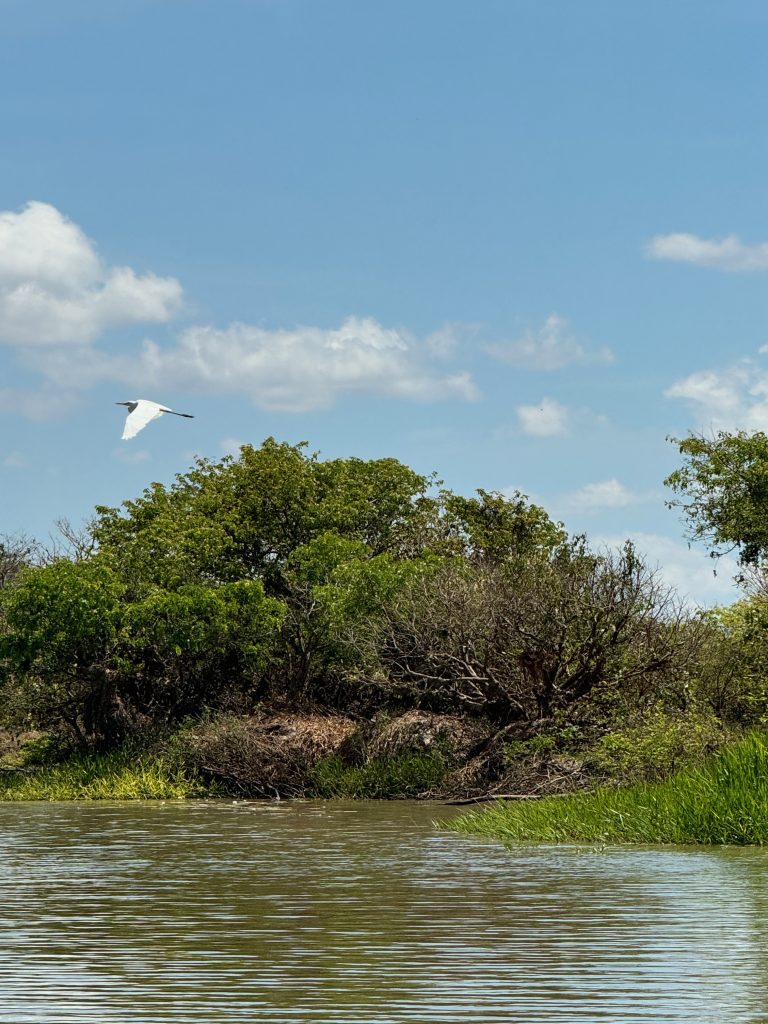
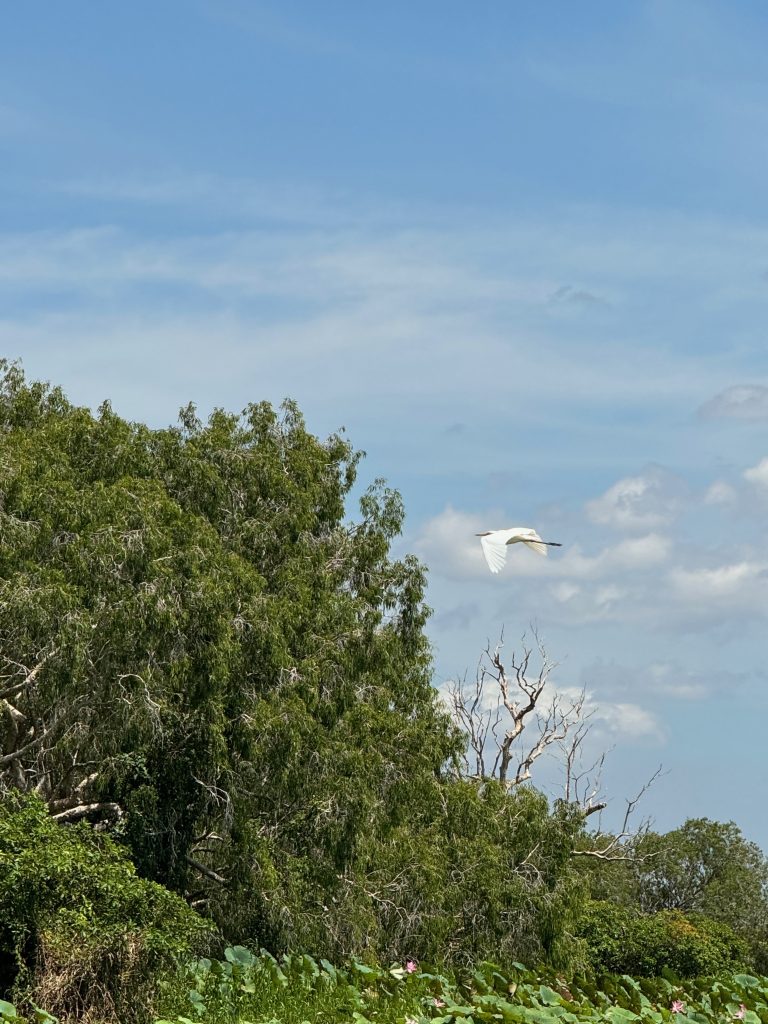
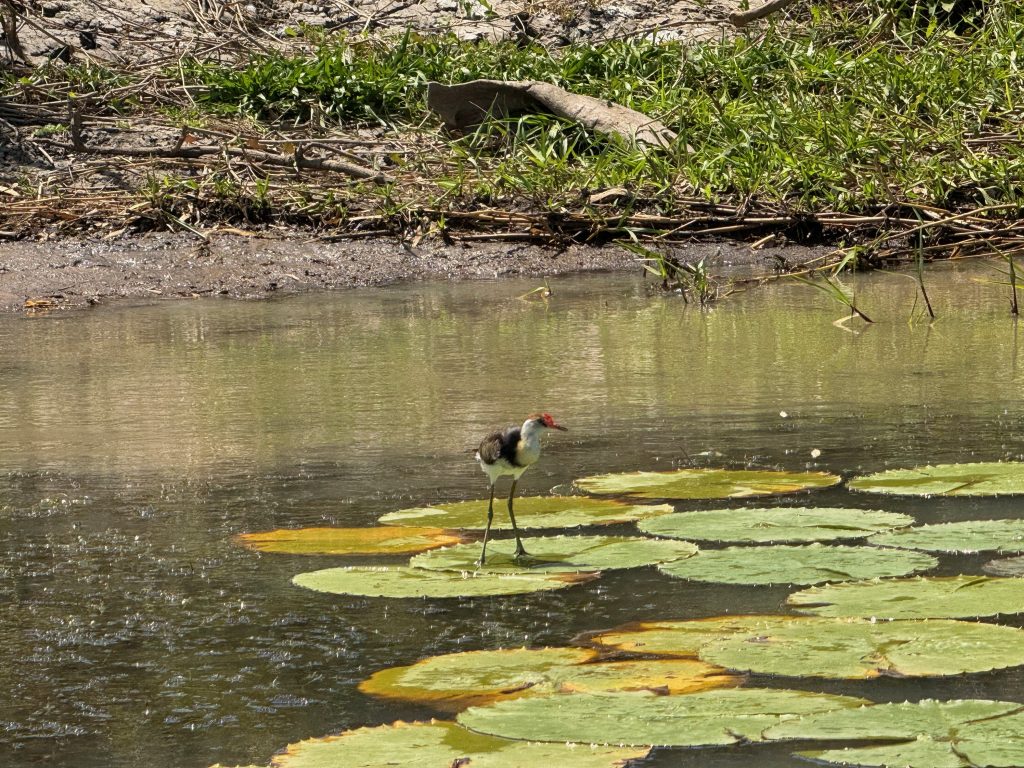
We saw a few of these little guys on the lotus patches. They have big long clawed feet, so they have excellent weight distribution so they can walk on the lotus leaves and not fall in. I can’t remember their real name, but their nickname is the Jesus bird, because they walk on water.
We saw a couple of baby ones, too scared to walk on the lotus leaves, watching their parent demonstrating how to hunt.
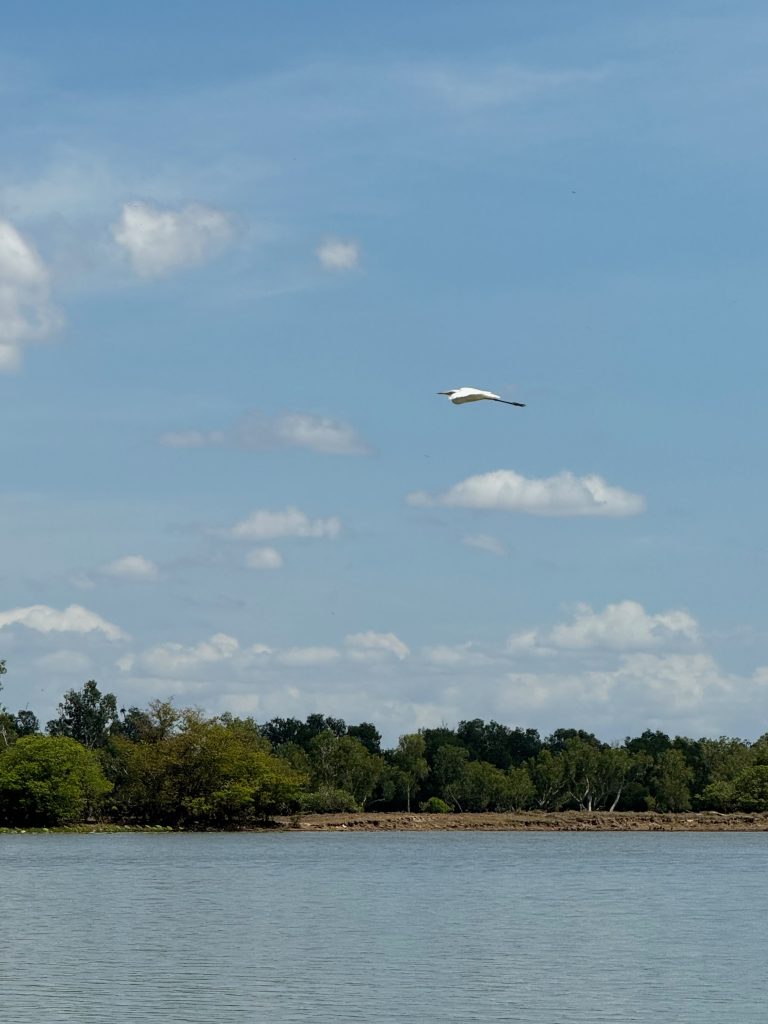
There were massive dragonflies zipping about the water, dipping down maybe to take a drink and then up again. It was impossible to take a photo because they’re just so quick, but I loved watching them.
As we were going along the river, the guide was watching out for wildlife on either side. Suddenly, he angled the boat towards what appeared to me to be an empty bit of shore.
“Can any of you see which animal I’m looking at?” he asked.
I was looking down for crocodiles, up for birds, around for wallabies – I couldn’t see a thing. But then the guy next to me nudged me and said, “Look straight ahead, through the trees.
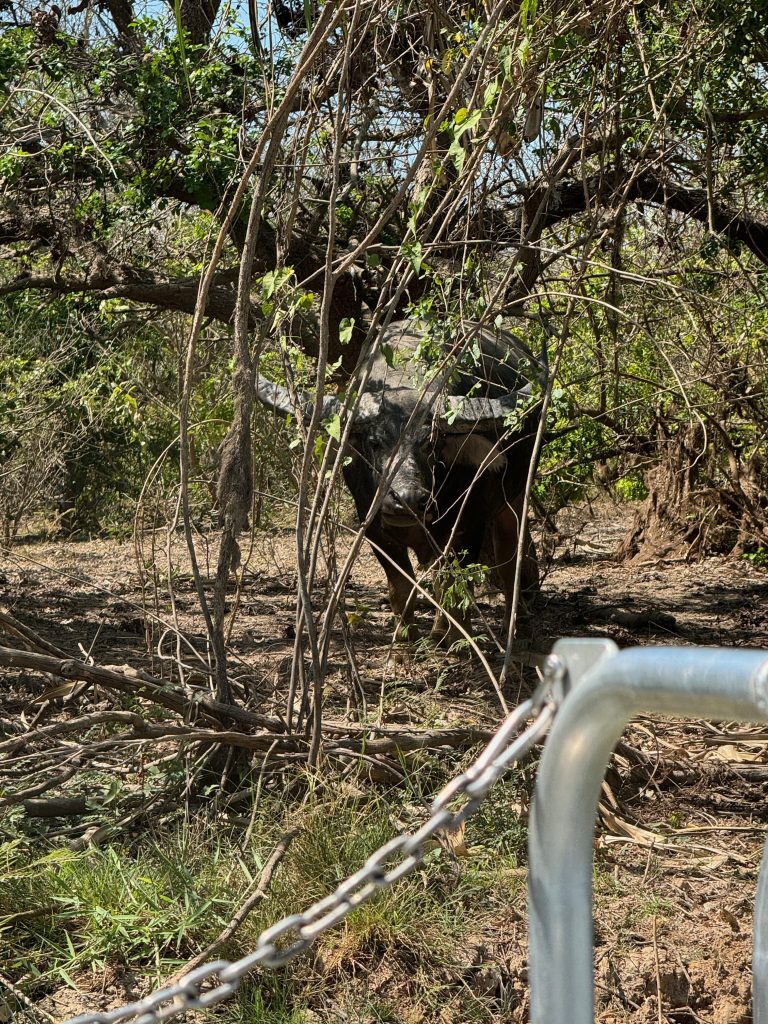
Bloody hell! It was a massive water buffalo! How could I not have seen it?
These animals are feral pests up here. Anyone in the NT who has a gun can shoot these and wild pigs at any time. They’re mainly gathered up and sold for dog meat by the cattle ranchers who are trying to get rid of them as they ruin the land.
He was eying us malevolently, and the guide hastily ran back to the end of the boat to manoeuvre us away. “Yeah, he’d be 350 – 400 KG, that one.”
This was when I realised that I was damned lucky not to have been born a settler’s wife. I’d last about 5 minutes out here on my own.
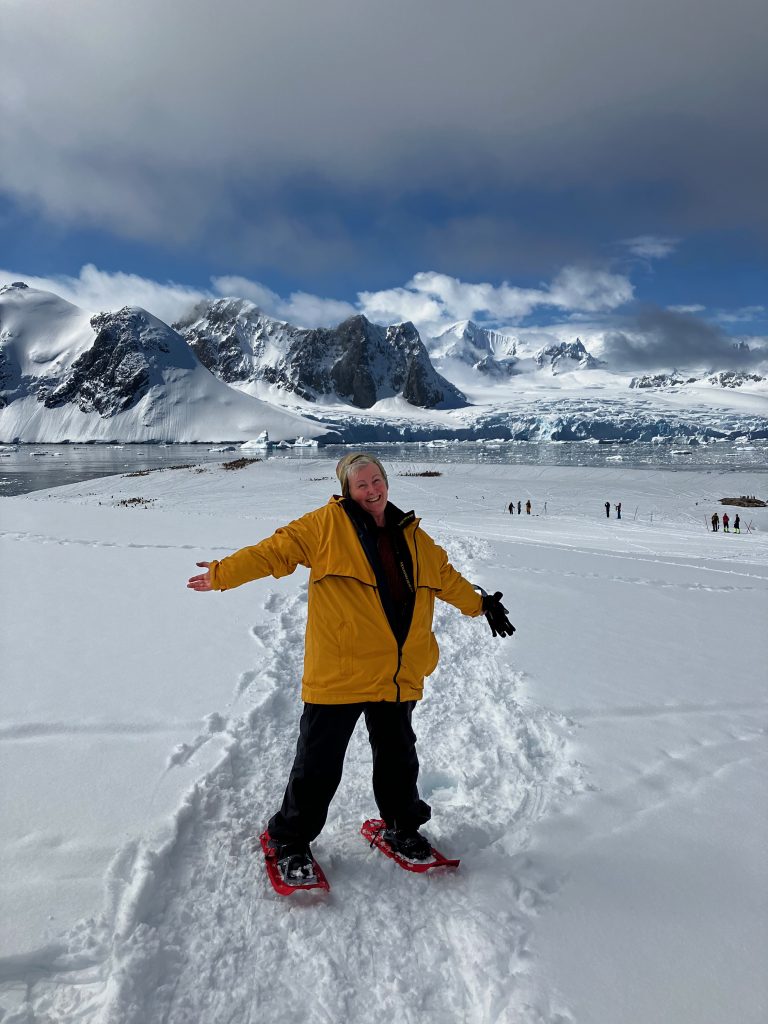
Look at my life. Two years ago I was here.
Now I’m up at the top of Australia, in 39C heat. I love my life at the moment. Fingers crossed I get all my travel done that I’ve planned for the next year.
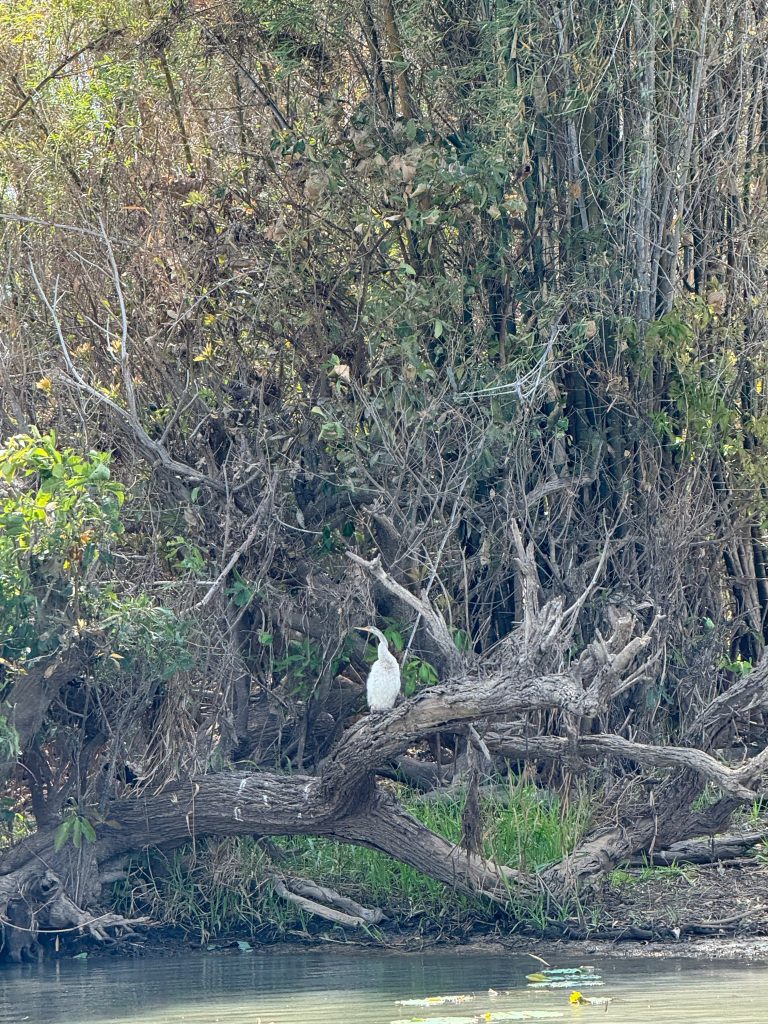
This is an egret. They’re everywhere. They owe their success to the fact that there’s absolutely nothing on the frames but feathers and bones, so even the crocodiles don’t want to eat them.
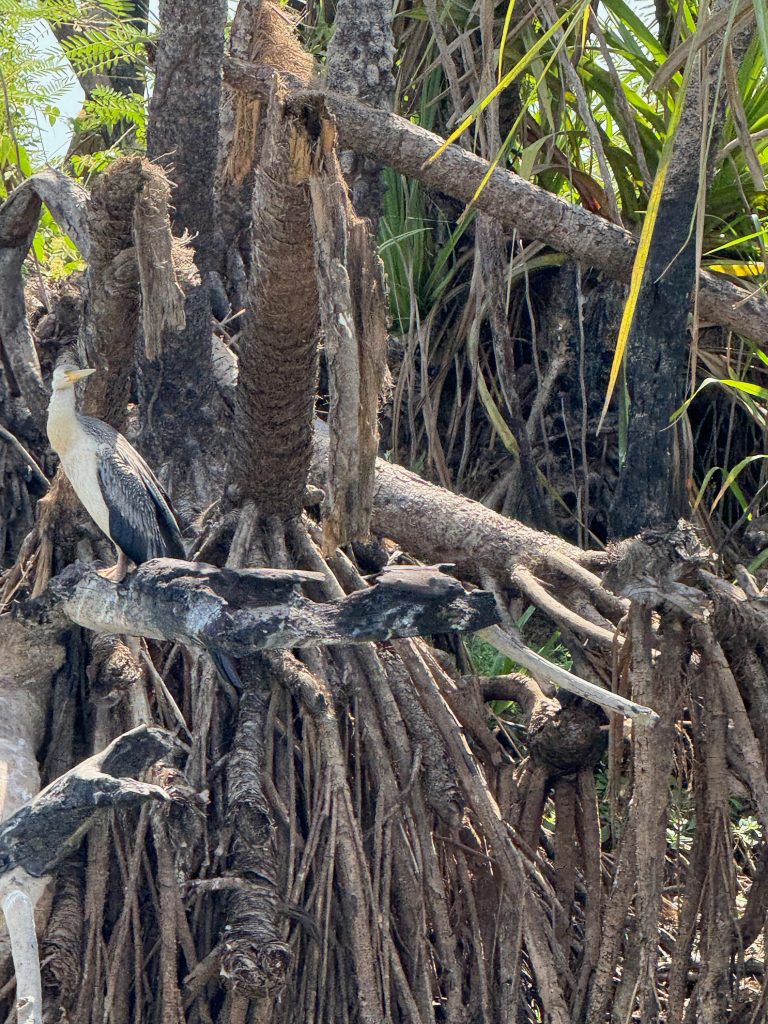
What was incredible to me was how much the animals and birds blend into the landscape.
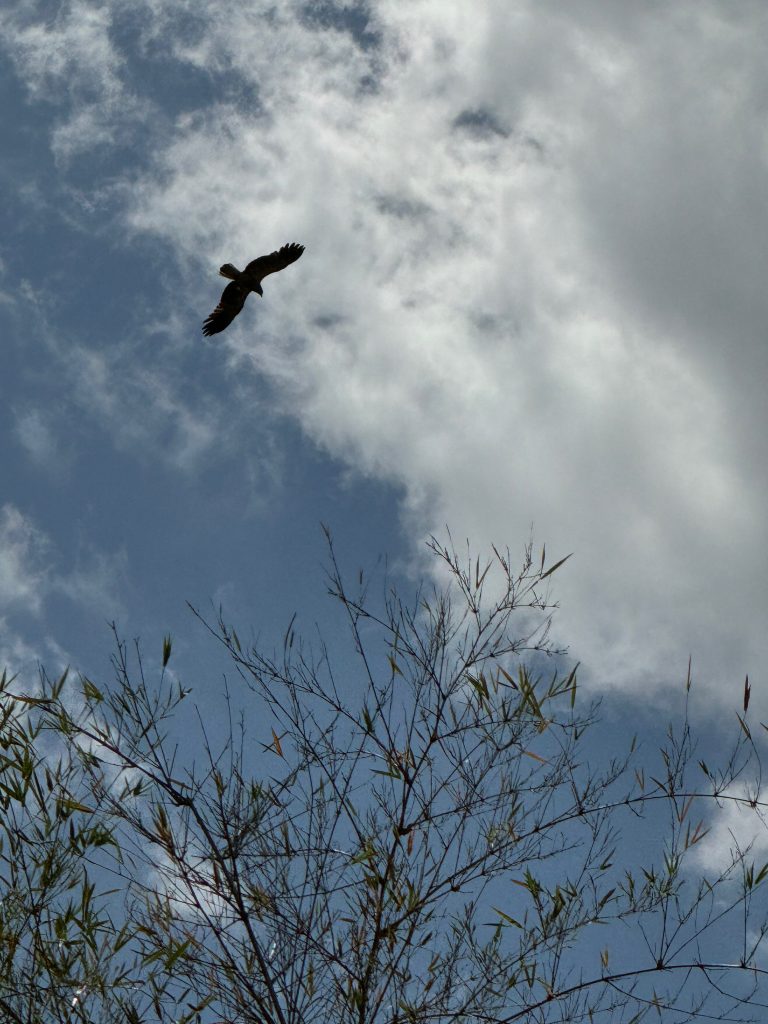
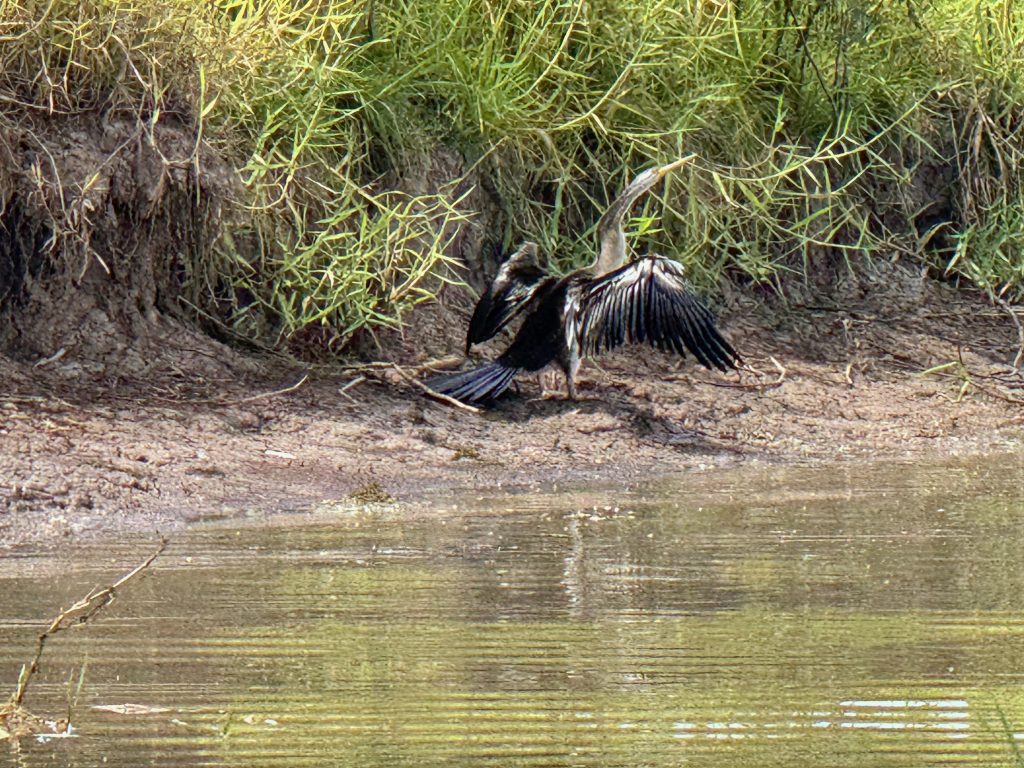
I was excited to see this: a cormorant holding out its wings to dry.
I saw this in Antarctica and Alaska. Now I’ve seen it here. How lucky am I?
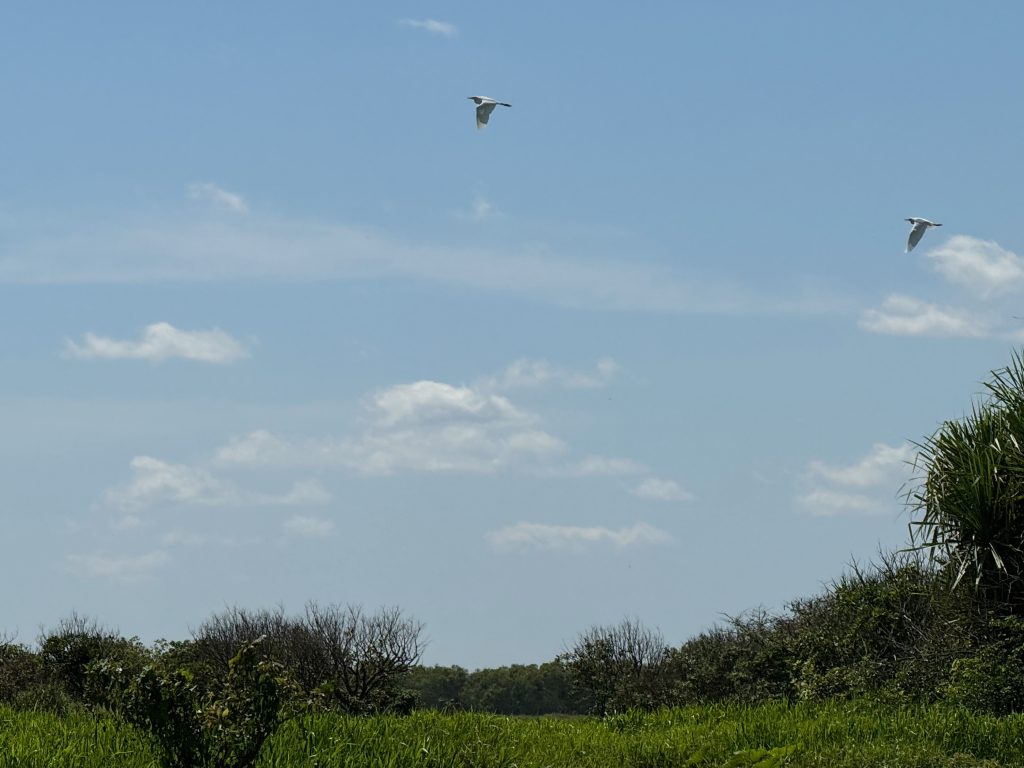
I apologise for all of the “birds in flight” shots, but I’m so pleased that I upgraded my iPhone after I was getting very disappointed with my photos from Alaska. Megan was getting far more detailed photos on her Samsung, so she knows exactly what I’m talking about.
I suffered from buyer’s remorse on the day I bought my shiny new bloody expensive phone. I’m sure my eye was twitching in shock as I left the Apple store.
Now, I’m getting some great shots and it’s made my holiday so much better. I really want to be able to show you exactly what I’m seeing. I love my phone now!
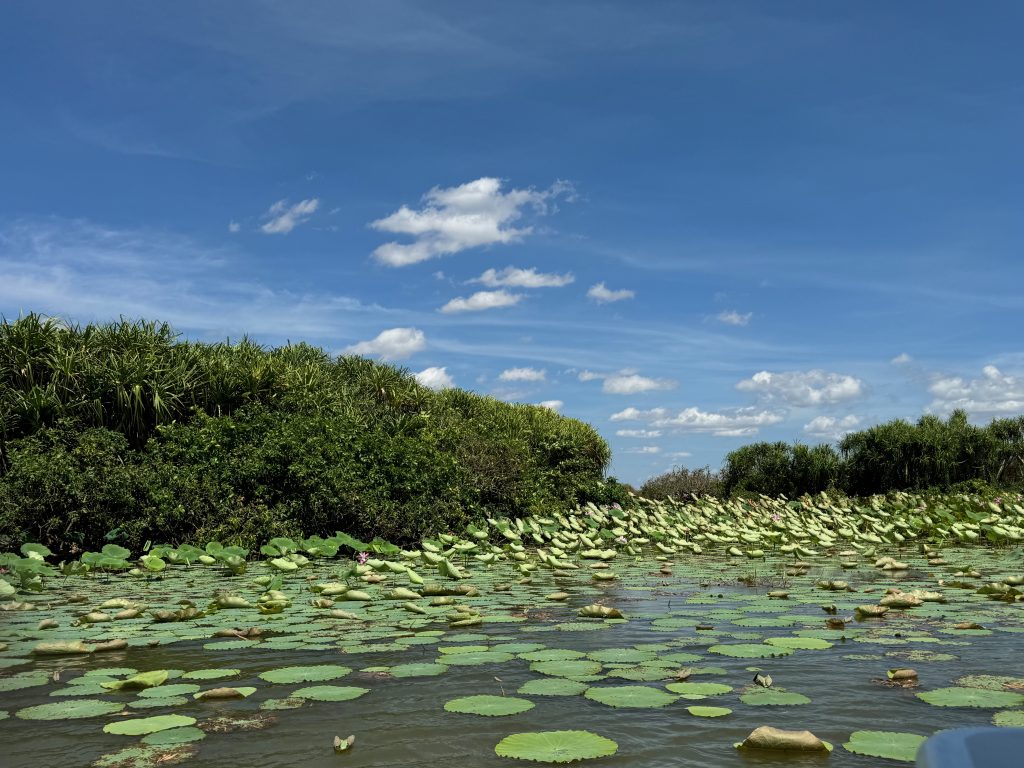
We slowly entered one of the many lotus fields along the banks of the river.
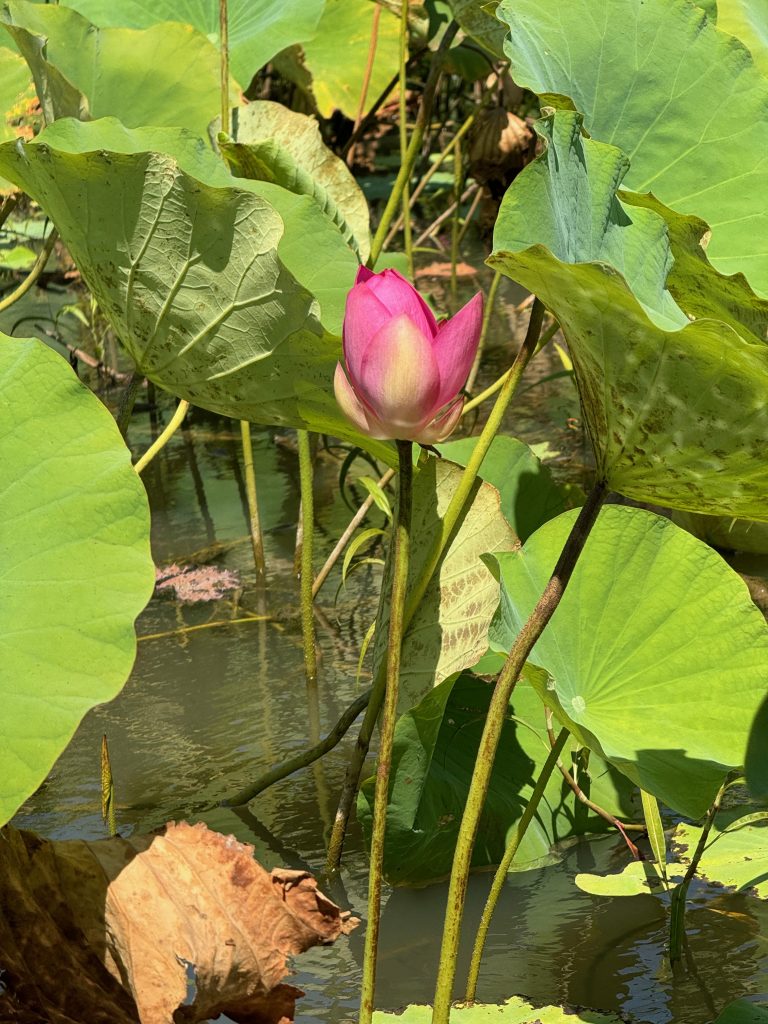
“Feet in mud, but creating beauty”, said our guide. The indigenous people use every single part of the plant.
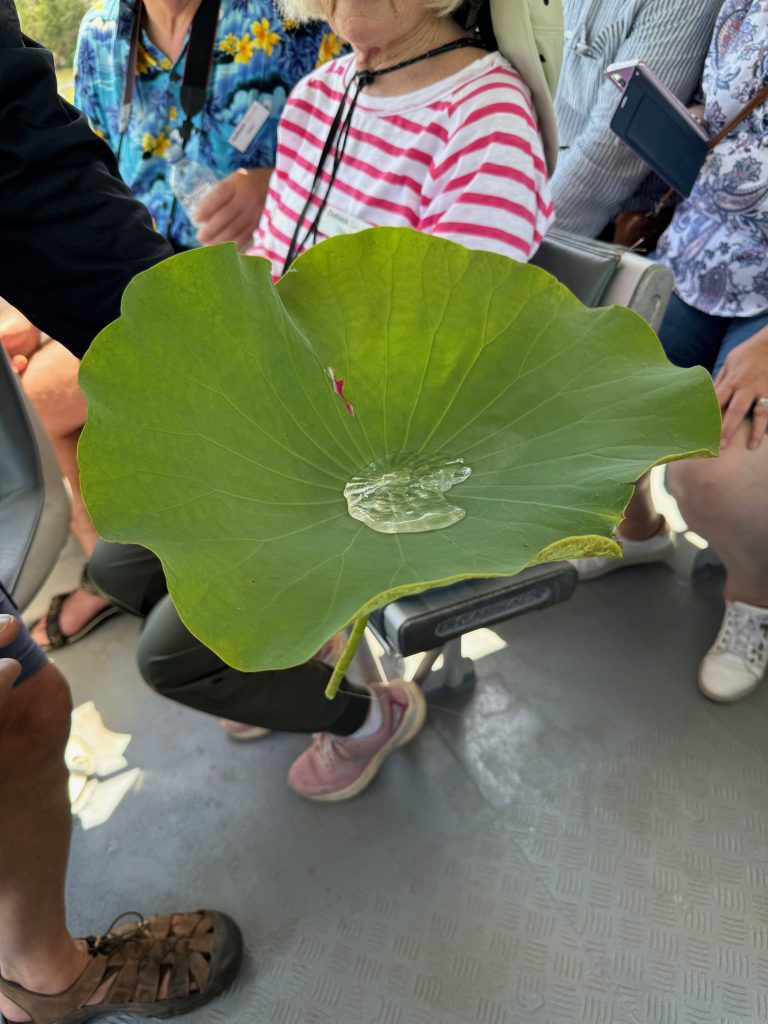
The leaf is water repellent. When the leaf gets rid of the water, it’s completely dry. This makes it very appealing to people who use the fibre for “silk.” Shirts made from lotus silk are a bit of a status symbol in places like Thailand, apparently.
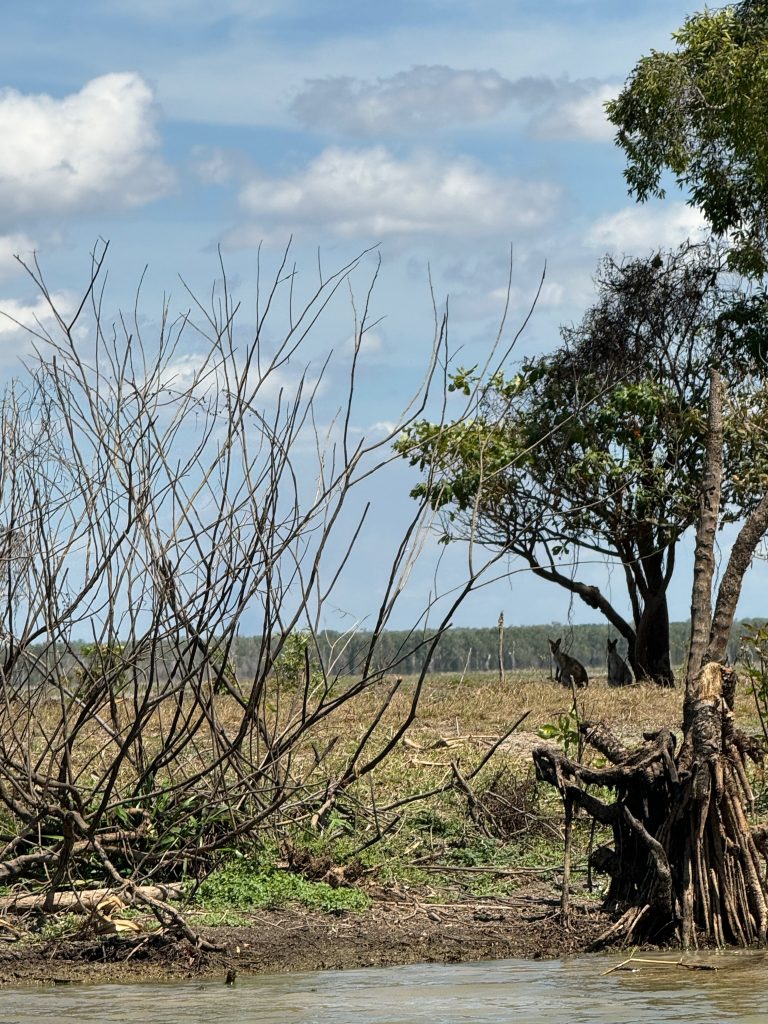
Wallabies! There are no kangaroos up in the Top End – it’s too hot for them.
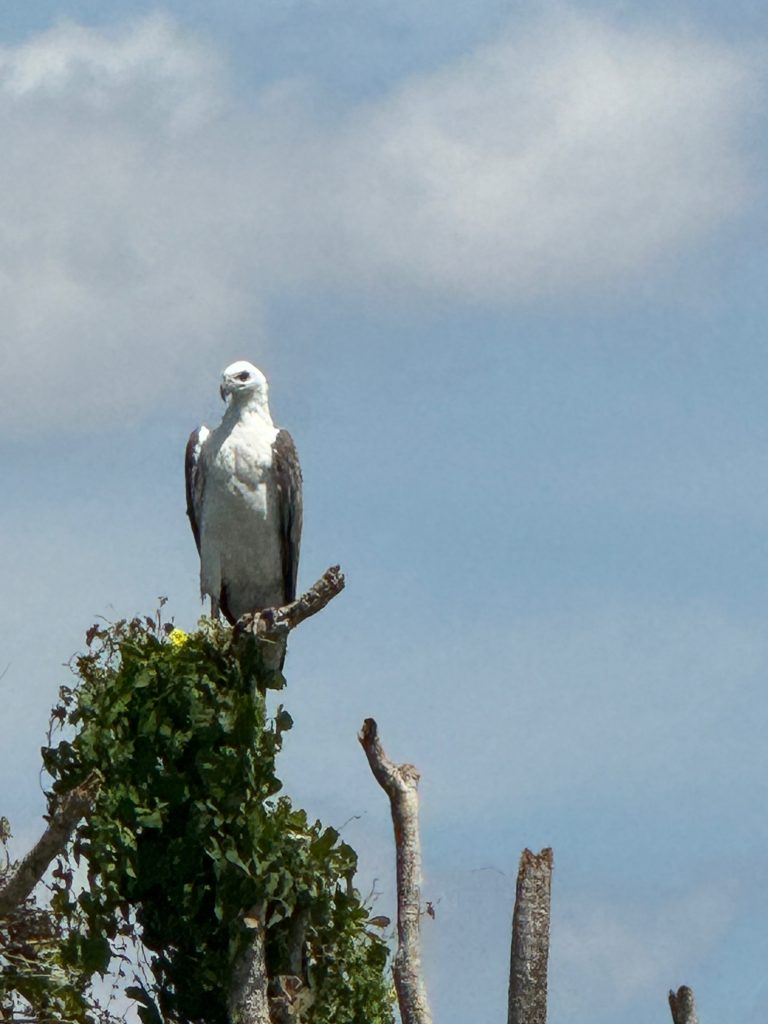
Then our guide got really excited. This is a White-Bellied Sea Eagle, or Manly Sea Eagle, the second-biggest eagle in Australia, after the Wedgie. (Wedge-tailed eagle, to those overseas people who don’t shorten names.)
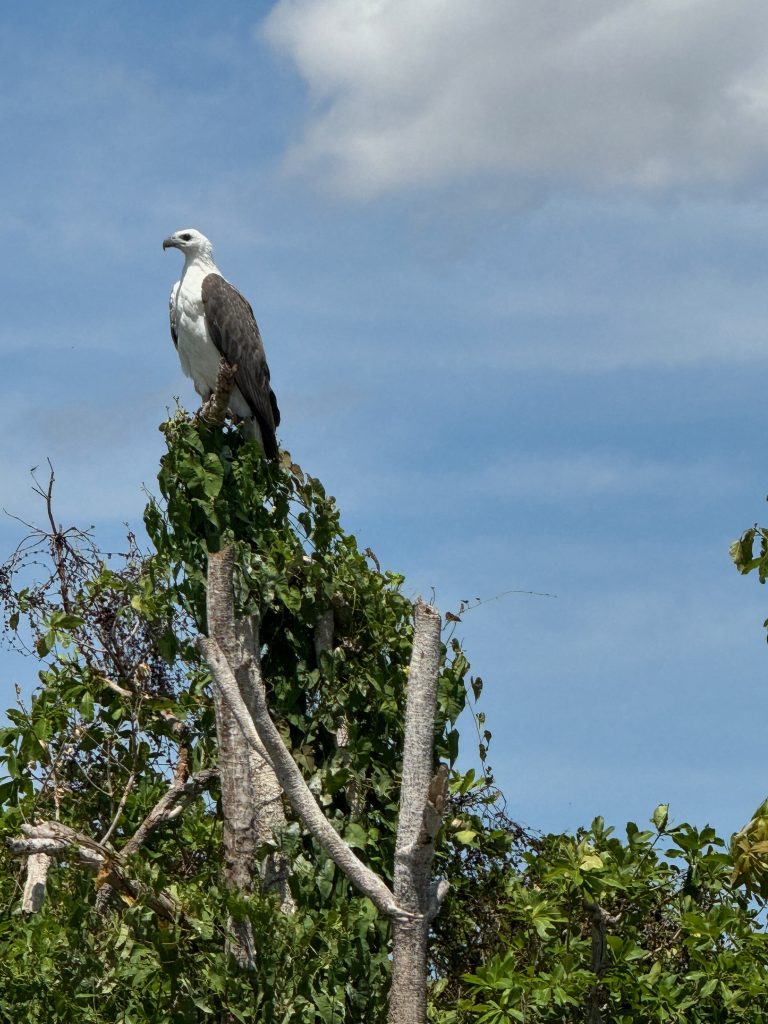
He sat there for ages, loftily unconcerned about us.
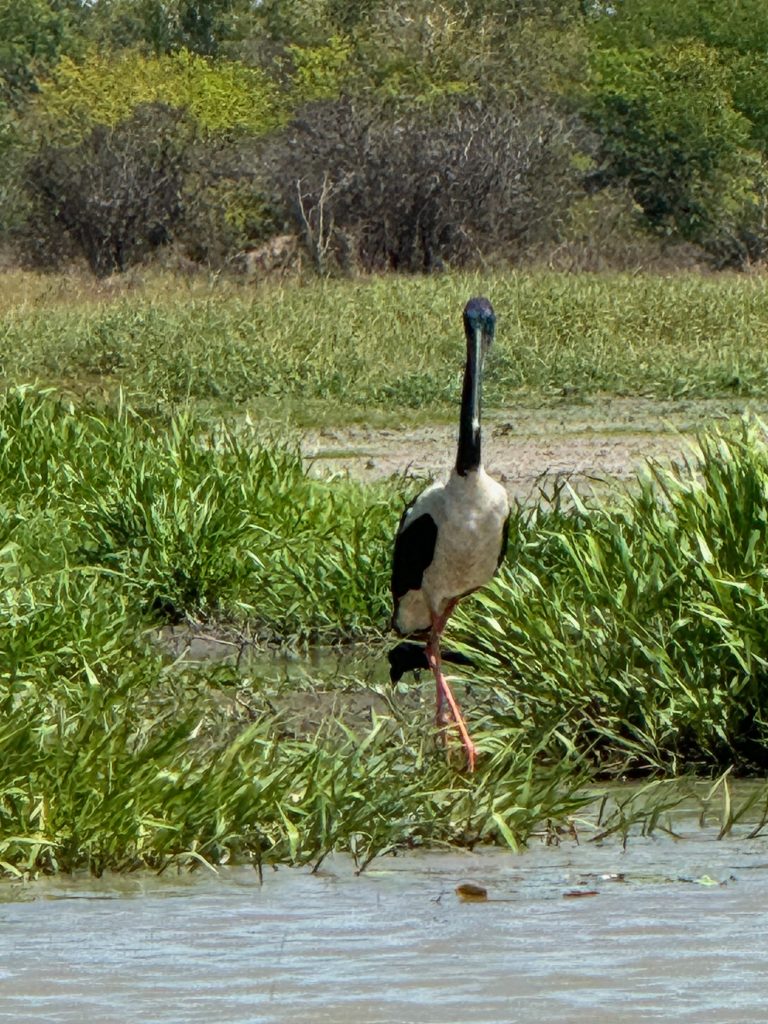
Then we all got a little excited. Down a side stream, we saw a Jabiru.
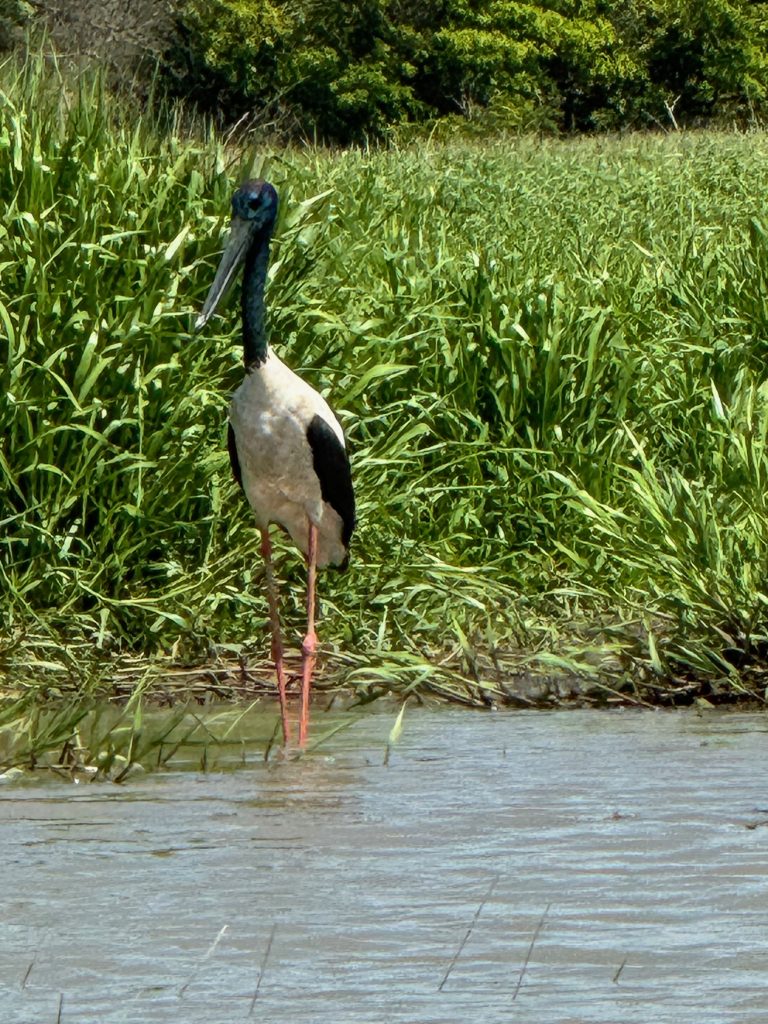
These ones also mate for life. He obligingly stood for quite a while, posing for us, before he stalked off into the reeds. You can get a hint of the iridescent feathers on his head.
I don’t know… he looked slightly goofy to me.
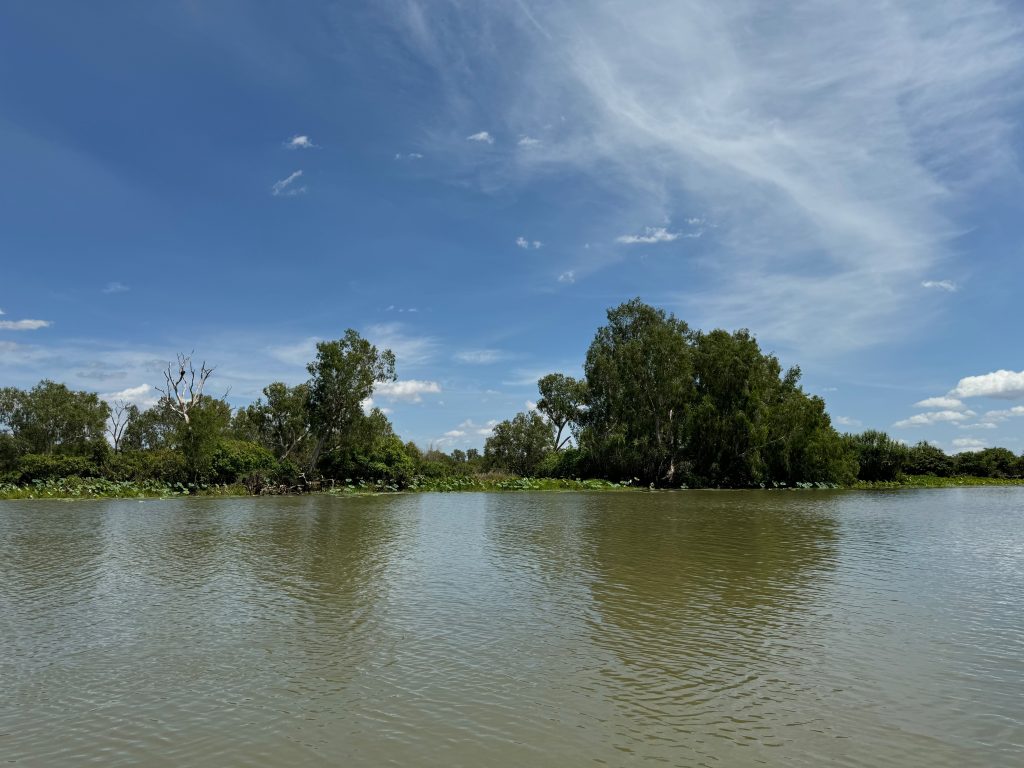
Then it was back to the bus to drive to The Bark Hut for lunch.
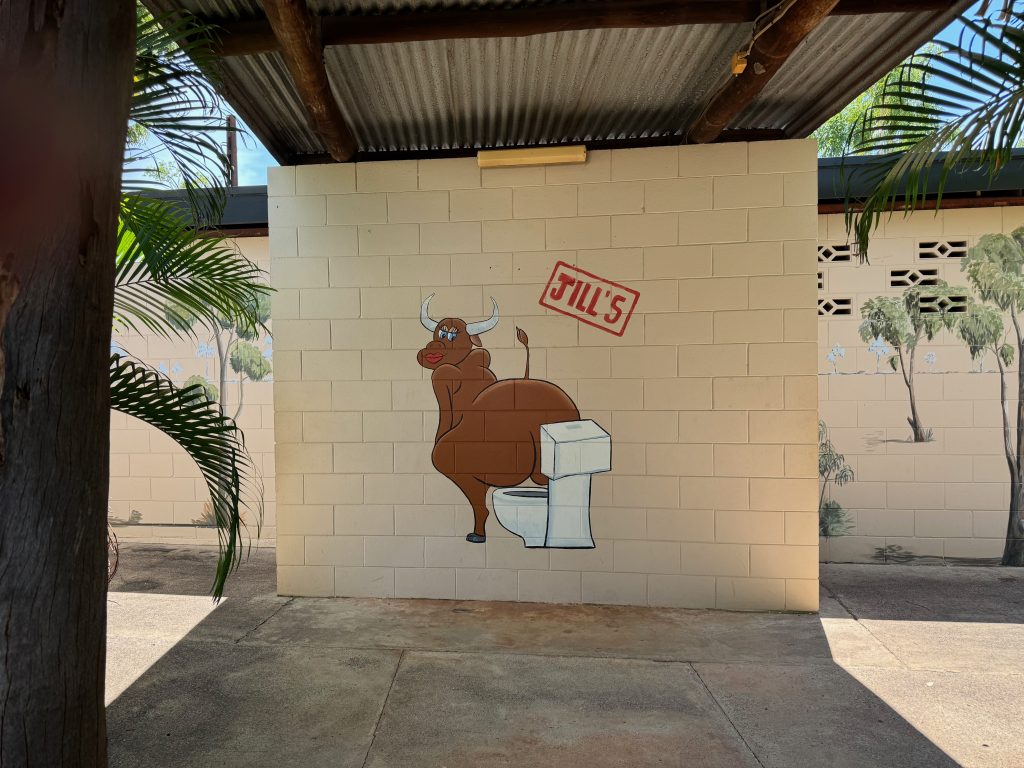
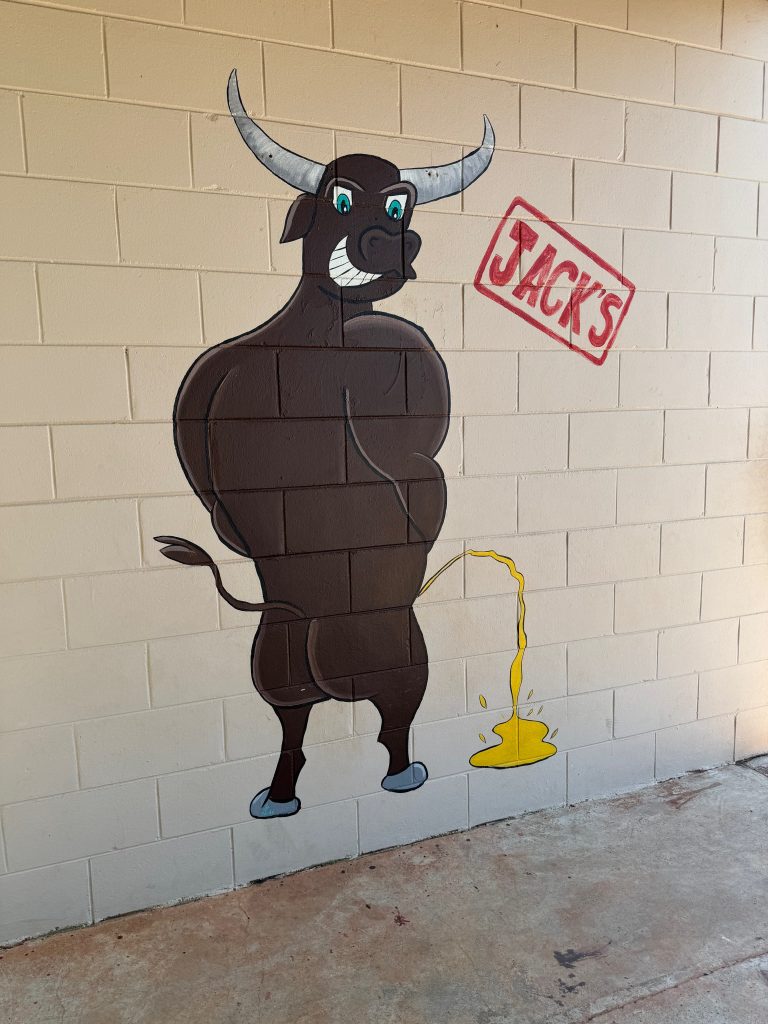
Just some Outback toilets…
Lunch here was really good. I have to say, both The Ghan and Outback Spirit, (the tour company that runs the Uluru and Kakadu tours I’m on), feed their clients remarkably well. And all drinks are included. This makes me a happy person, as I like a G & T when it gets hot. And here – it’s HOT.
After the Bark Hut was when I got annoyed. Remember how I said I had an emty seat next to me? As I was settling myself for the next part of the drive, one of the elderly men approached me and asked if I he could sit next to me, as he was in the sun on the last drive.
“I was eyeing off that empty seat beside you for the whole morning,” he said.
I sighed to myself, but said to him that it was okay. The next thing I knew, he was grabbing my backpack to put it up in the shelf over the seats, where I couldn’t reach it. For those who don’t know, I have a chronic cough and I need to be able to grab my chewing gum/throat lozenges/water to stop it. All of that stuff is in my backpack, at my feet.
“No, no,” I said. “I want the bag down with me, thanks.”
“Oh no,” he said, continuing to shove it on the shelf. “It’ll be much better up here.”
I was pissed off. This was my bag, and he was telling me what he considered was right for me, while muscling into my space. Geeze, it’s not as if I was married to the guy!
“Excuse me!” I said. “I want my bag down here, where I can reach it. I have things for my cough in it. “
“I don’t mind if you cough” he said.
I hardened my tone just a little. “Will you please stop putting my bag where I don’t want it, and hand it to me please?”
Then I raised me voice and spoke to the hole bus.
“If you want protection from the sun, there are blinds that you can pull down. They’re on each window.” I knew this becase the bus was the same as we had in Uluru.
People started pulling them down and he sat down beside me. I’m afrad I didn’t make him seem very welcome, as I kept my attention on my iPad wheile I was making notes for this blog post.
When the bus began to slow down, he grunted, “I needn’t have moved. I’ve been sitting in sunshine this whole drive.” He was, too. Someone on the other side hadn’t moved their blind and he was bathed in the stuff.
He didn’t try to sit with me again.
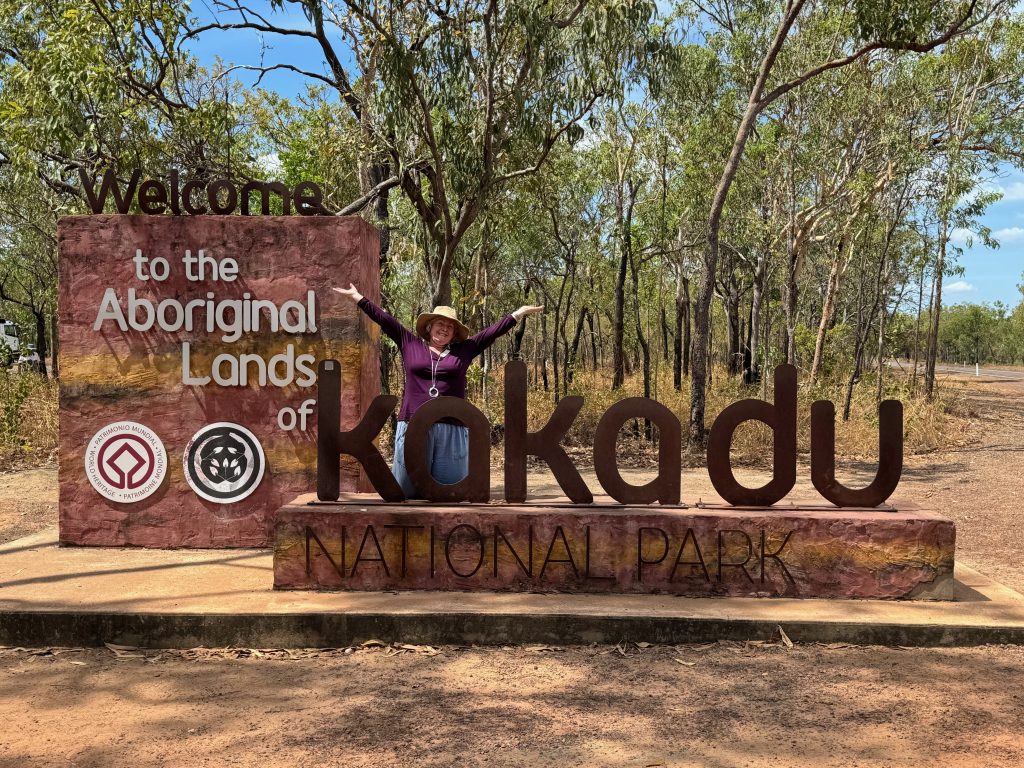
Woo hoo! We’ve made it! We’re now in Kakadu.
We went to see the Visitor’s Centre, which wasn’t much chop, to be honest. The walk to the wetlands was much better.
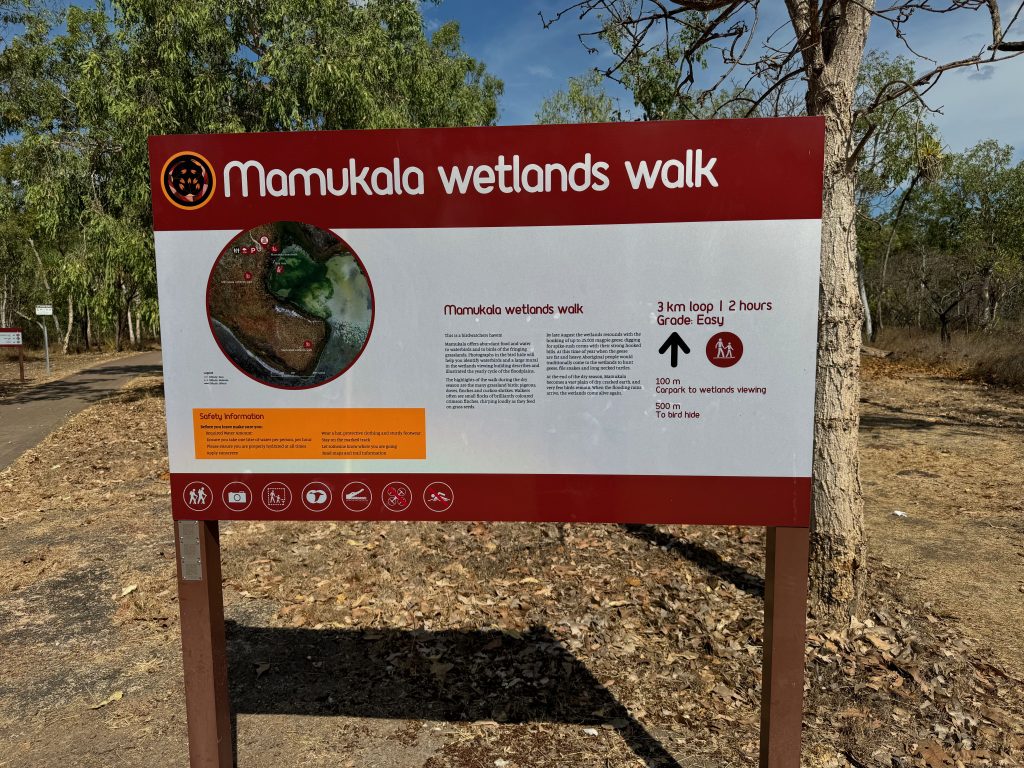
It was a very hot day. I was so thankful that Outback Spirit had given me my broad-brimmed hat. I was slapping on the sunscreen before we left the bus.
I’m experimenting with wearing the merino tops that I bought to wear in Antarctica. Merino is supposed to be good for both hot and cold climates, so I thought I’d give them a go, particularly as I was only taking carry-on luggage. So far, it’s been really good. I haven’t needed to duck into a hotel gift shop and buy “I LOVE THE NT!” teeshirts because I’m too hot with the merino. It don’t allow sunburn under it, which is what I’m primarily concerned about, with my lily-white skin.
So far, I’d say merino is fine to wear down in the Alice Springs area, though maybe it might be getting a bit too warm for up here. Oh well. I only have a few days to go!
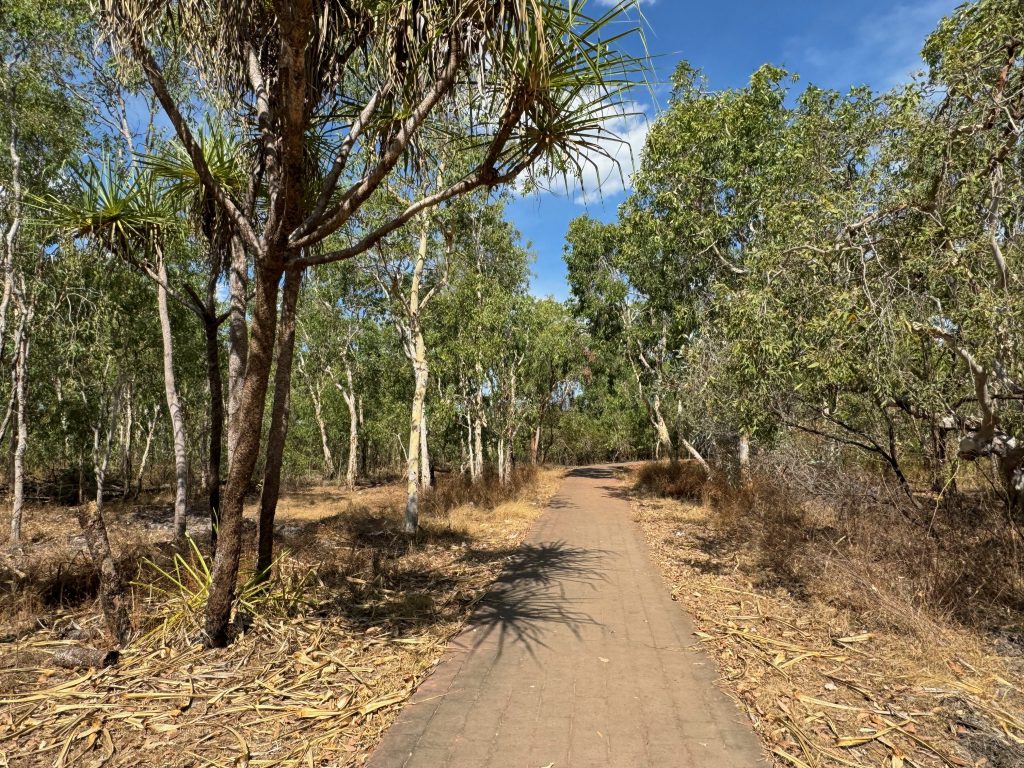
Of course, I was the first one to set off down the track. I like to be first.
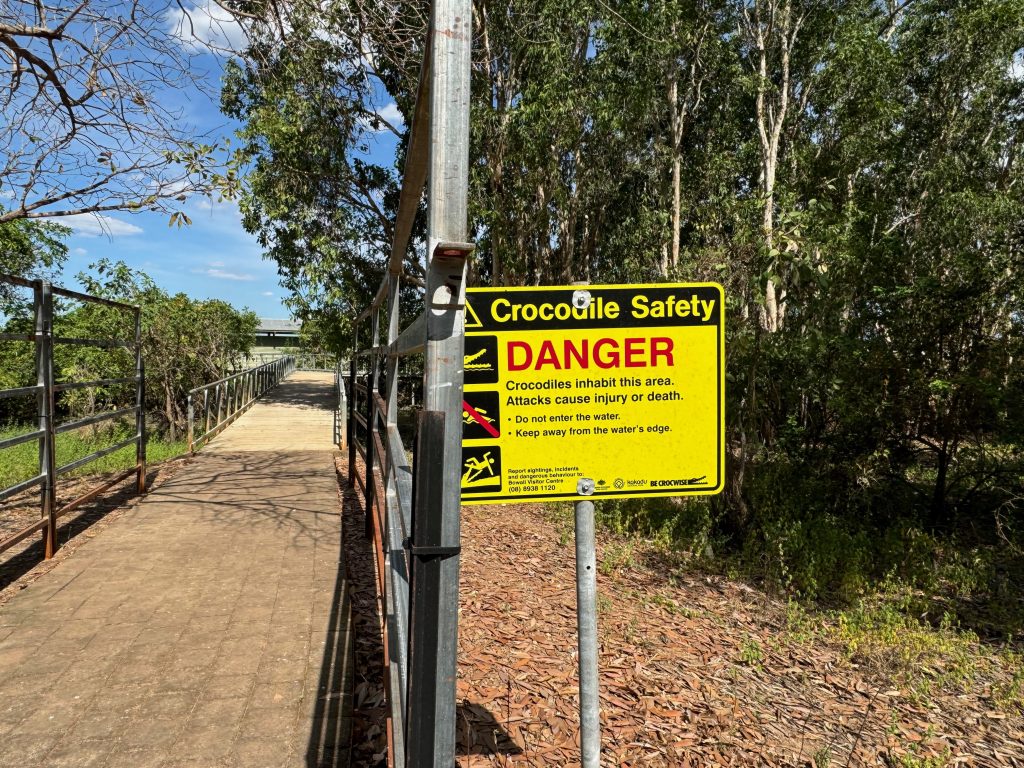
But then… is it wise to be the first one?
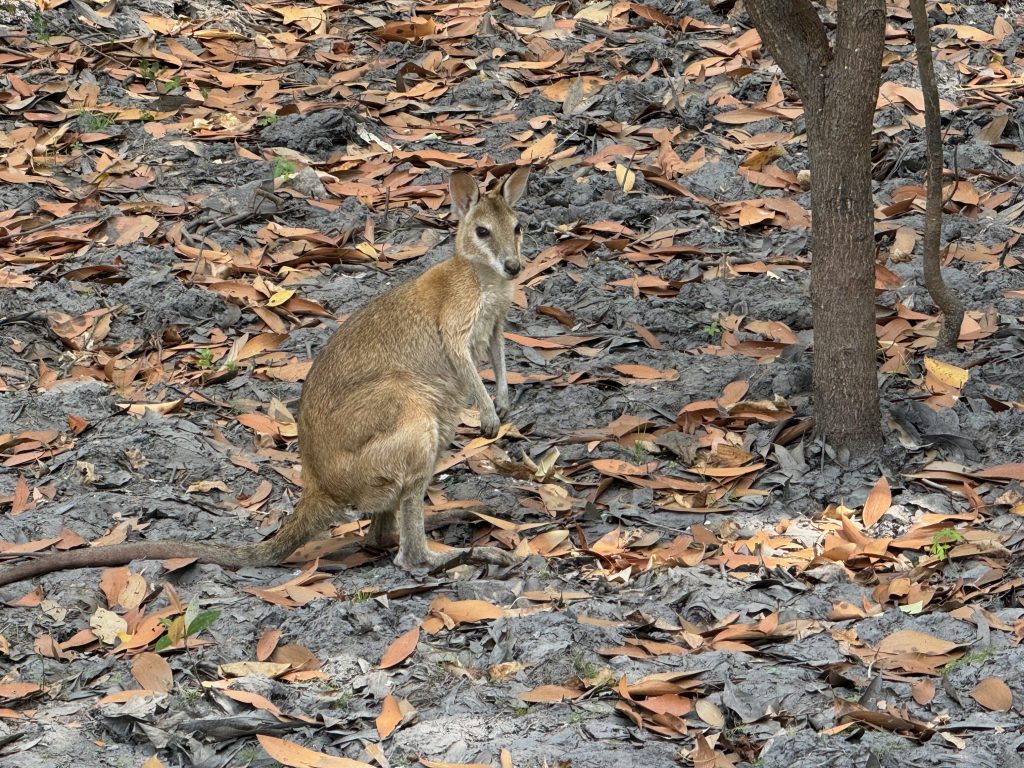
Why yes. Yes it is.
I was walking quietly, when I saw a small family of wallabies under the trees to the right. I was focussing my camera when the noise of talking humans frightened most of them off. I was saying, “SHHHH!” to my fellow travellers while I took this photo.
They were saying loudly, “WHAT?”
Surprisingly, I was the only one to see them.
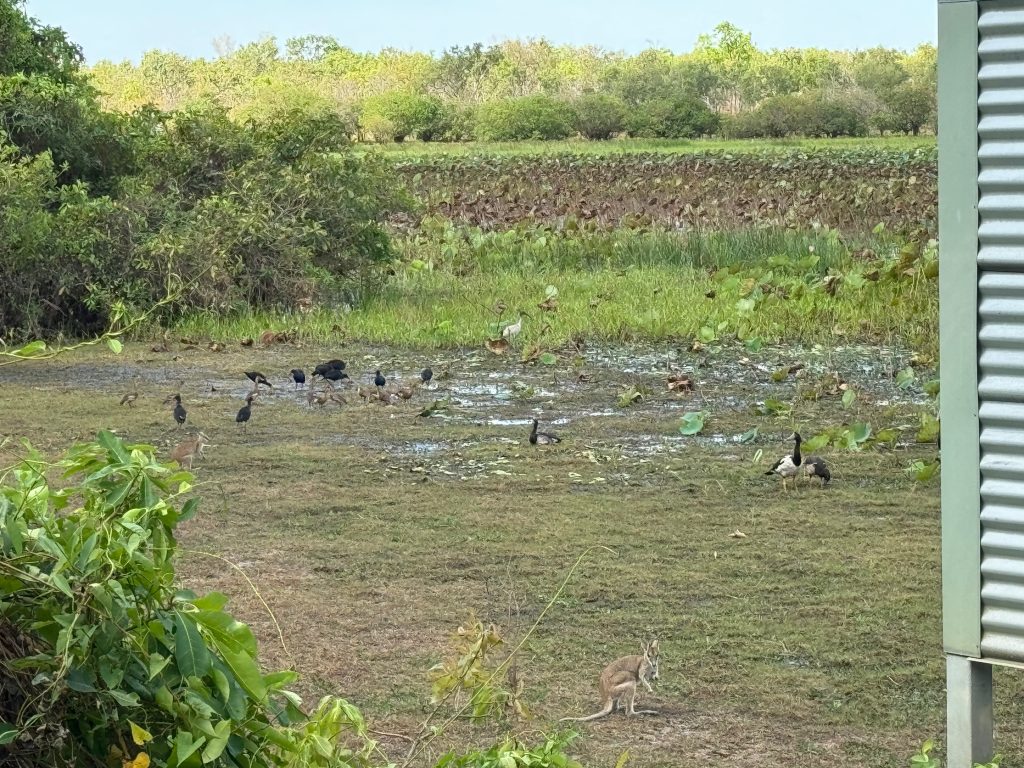
We were going to a bird hide, overlooking the wetlands. All of these birds were beside the hide as we came up the boardwalk.
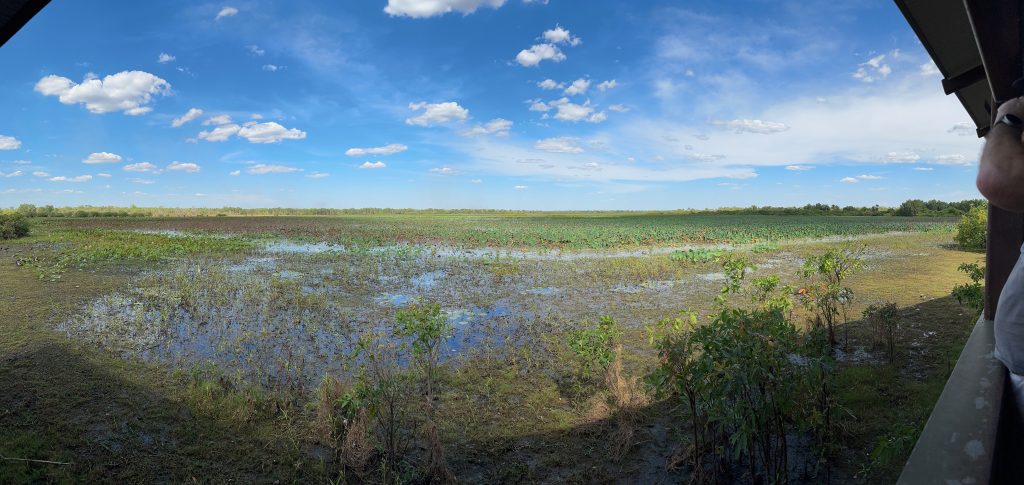
Using the skills I learned in Canada two months ago, this is a panorama of the scene in front of us.
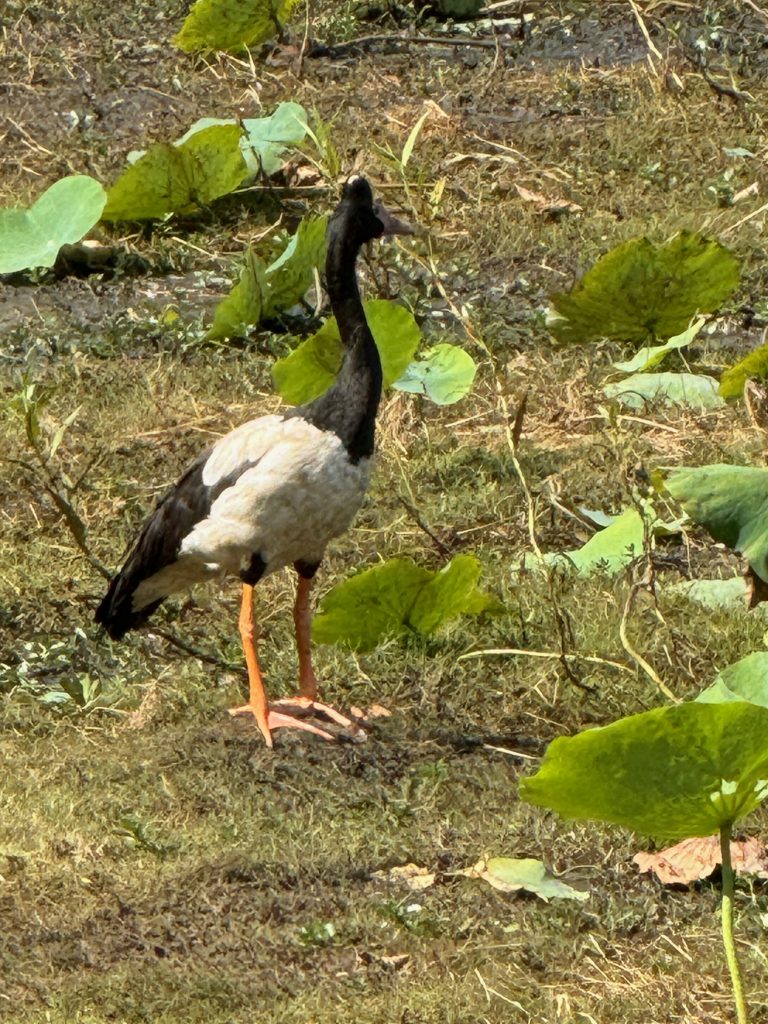
According to Pascal, these geese are “good eating.”
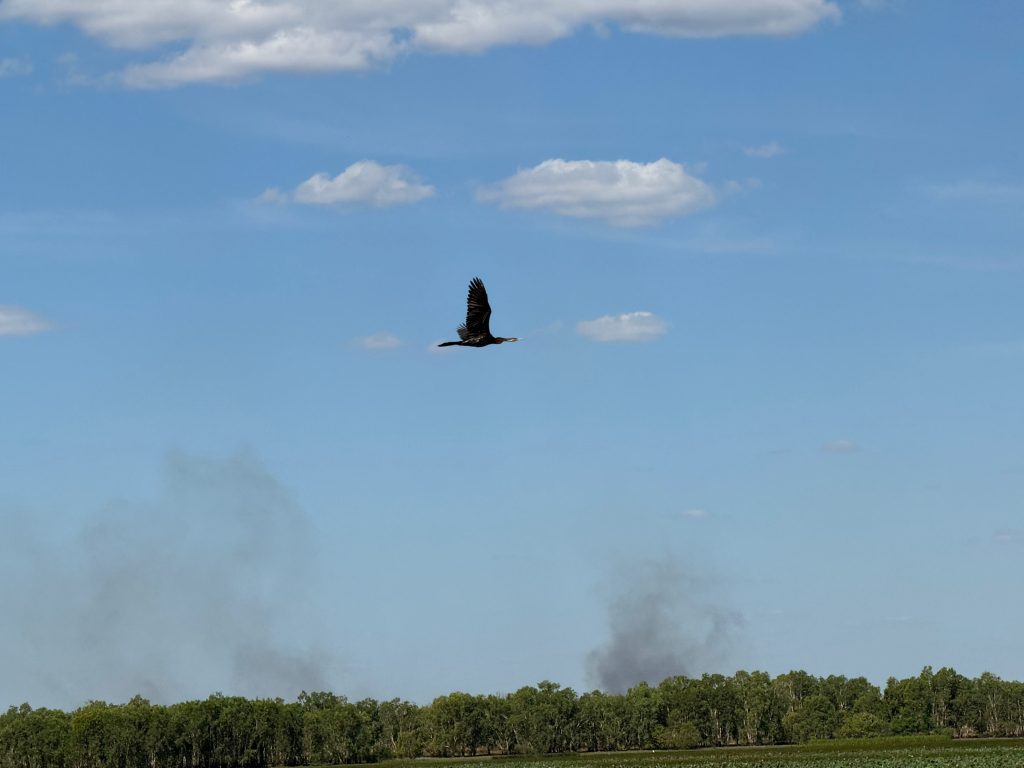
The fires would have been started by rangers, locals or the Whistling Kites. They are known to pick up burning embers and drop them somewhere else, to flush out the small rodents they eat. Smart birds.

We are staying for a couple of nights at the Crocodile Hotel in Jabiru.
It was funny when we got there… they’d had no power for a few minutes just as we arrived, then as soon as I was in my room, there were huge sirens and “EVACUATE!
It was just like when I was all packed, ready to leave my hotel in London to go to Corinna’s place. This time I was arriving, but all my things were still packed.
I like an evacuation when you can simply take all your gear with you.
Jabiru was originally a mining town. The movie ‘Crocodile Dundee’ changed all that. Tourists started pouring in! There used to be 50 coaches coming into Kakadu every day.
So the Crocodile Hotel was built and it morphed into a tourist and mining town.
Then the Fukushima nuclear accident happened. It was using uranium mined from this area. The traditional owners said, “ I told you so. When you take things away from the land, bad things happen.”
Japan and other countries turned away from nuclear power and are now using natural gas from the Timor Sea. In 2019 the Ranger nuclear mine shut down. Rio Tinto was originally going to bulldoze their buildings in Jabiru, but after consultation with the locals and the Northern Territory government, they left the town as it was.
Jabiru had to find a new source of electricity and they now use solar. It’s now pretty much a tourist centre.
Tomorrow is going to be a big day. We’re seeing a lot of different things in Kakadu. It’s still almost surreal that I’m actually here at the top of the country.
Dad joke of the day:

Love your bird photos. It’s an amazing place.